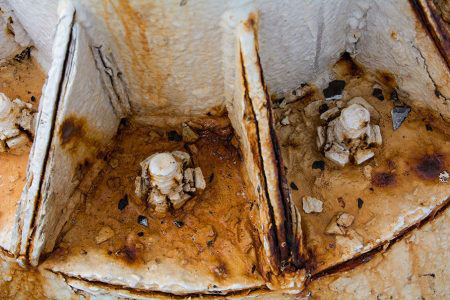Why Your Conveyors Must Account for the Hateful 8 of Corrosion
If you’re moving material in the pulp and paper industry, you’re all too familiar with corrosion.
That’s the deterioration of a metal as a result of chemical reactions between it and the surrounding environment. Unfortunately, keeping corrosion in your conveyors to a minimum isn’t as simple as applying a highly corrosive-resistant surface to everything and calling it a day.
 A comprehensive solution to specific conveying challenges in the pulp and paper industry involves accounting for all of the variables that contribute to corrosion. We’ll call them The Hateful 8:
A comprehensive solution to specific conveying challenges in the pulp and paper industry involves accounting for all of the variables that contribute to corrosion. We’ll call them The Hateful 8:
- Material shape
- Material chemistry
- Placement of equipment
- Moisture
- Environmental factors
- Excessive heat
- Vapors
- Conveyor speed
Why is it so important to combat corrosion by addressing every variable? The financials speak for themselves. The industrial sector is one of the largest and most important drivers of global economic growth and stability. The pulp and paper industry in particular represents billions of dollars. As stated in the 2016 U.S. Paper Mills Report, paper mills in the U.S. accounted for more than $44 billion in revenue in 2016. According to Statista, worldwide production of paper and cardboard was more than 407 million metric tons (mt) in 2015, while revenues for the U.S. forest, paper & packaging (FPP) industry exceeded $96 billion.
Perpetual Motion
Those numbers essentially equate to constant production, which relies on effective and reliable infrastructure – specifically, conveyors that must move a diverse assortment of materials located in some of the harshest environments on Earth. One of the biggest challenges facing pulp and paper operations is keeping those conveyors, and the materials they transport, moving 24/7.
Threatening that efficiency is the constant possibility of corrosion and the downtime it can cause any operation. When components fail on a conveyor, it must be shut down for repairs. This unplanned downtime, in addition to the costs required to repair the equipment, can significantly reduce production goals and ultimately impact an operation’s bottom line. If left untreated, relatively small parts affected by corrosion can take down a conveyor, costing a company’s operation in excess of a $1 million a day.
The World Corrosion Organization estimates the global cost of corrosion to be about $2.2 trillion annually. On a positive note, the organization estimates that as much as 25% of that amount can be eliminated or significantly reduced with a comprehensive conveying solution. As that percentage indicates, you cannot completely stop or prevent the corrosion of metal. But you can work with CDM, where we design conveyors to optimally withstand all of the Hateful 8 variables that exist in your application.
The Subject of Sludge
For example, a dry application may have a conveyor that lasts 10 years while the same application that is wet, such as sludge, will last only two years. Sludge contains excessive moisture that can be highly corrosive due to heightened pH levels adding acidity or alkalinity to the material. Even the humidity or the vapors that can be created from moving sludge at high temperatures is enough to begin corrosion of metal components. So, the actual texture of any material is not necessarily a deciding factor on mitigating corrosion. Accounting for all of the material’s chemical properties is critical.
Since corrosion can’t be stopped, the best way to mitigate its effects is to manufacture a conveyor correctly from the start. All CDM conveyors are designed and built on a per suit basis that allows tailoring the conveyor construction and materials to the application. CDM engineering and design principles are founded in the science of material movement and bulk density, the technology of optimum chain speed intersecting acceptable chain pull, and the innovation of wear resistance and anti-corrosion techniques.
To be profitable, an operation must trust that its equipment can deliver materials in a consistent, controlled and reliable manner. CDM partners with companies to design the correct conveyor for every specific application, one that will meet the demands of any operation – and keep the Hateful 8 at bay.
Read our white paper for more in-depth information about CDM’s corrosion solutions for the pulp and paper industry.
———
About CDM
The CDM story is about recognizing every industrial operation is different, as are their conveying challenges. A custom-engineered conveying system is a cost-effective approach to any operation willing to look at the value of having a partner who is vested in your success and one who stands by their product. CDM has earned more than 91 percent repeat business because we’re more than just a conveying systems manufacturer – we’re a business partner.
For further information contact:
Andrew Parker, President CDM Systems, Inc.
Browse By Benefit
Categories
- Blog (40)
- Case Studies (9)
- News (7)
- Product Information (7)
- Tech Briefs (3)
- Technical Documents (33)
- Uncategorized (1)
- Videos (12)
- White Papers (5)

